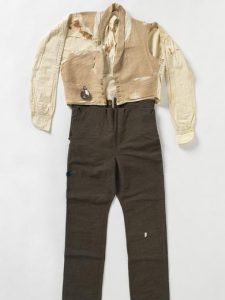https://history.lds.org/article/hyrum-smith-clothing?lang=eng
Church History Museum
Museum Treasures
25 November 2015
 These artifacts are perhaps the most intimate remembrance of the martyrdom of Joseph and Hyrum Smith: they are the clothes Hyrum was wearing when he was killed, the watch he carried in his pocket that day, and a pair of sunglasses he owned. They show the bullet holes and bloodstains that tell of his death at the hands of an angry mob. As significant as his death was, however, of greater importance are the life he lived and the love he had for his brother Joseph.
These artifacts are perhaps the most intimate remembrance of the martyrdom of Joseph and Hyrum Smith: they are the clothes Hyrum was wearing when he was killed, the watch he carried in his pocket that day, and a pair of sunglasses he owned. They show the bullet holes and bloodstains that tell of his death at the hands of an angry mob. As significant as his death was, however, of greater importance are the life he lived and the love he had for his brother Joseph.
Hyrum’s Faith
Hyrum believed that Joseph had been called of God, and he never wavered in that knowledge or his faith. Like Joseph, he was persecuted and jailed for his beliefs. After spending months in Liberty Jail under deplorable conditions, he wrote:
I had been abused and thrust into a dungeon, and confined for months on account of my faith, and the “testimony of Jesus Christ.” However I thank God that I felt a determination to die, rather than deny the things which my eyes had seen, which my hands had handled [the plates from which the Book of Mormon was translated], and which I had borne testimony to, wherever my lot had been cast; and I can assure my beloved brethren that I was enabled to bear as strong a testimony, when nothing but death presented itself, as ever I did in my life.
Hyrum later served beside his brother the Prophet as Patriarch to the Church and Assistant President of the Church. As a member of the Nauvoo Temple building committee, he encouraged everyone to participate in building the temple. He was a vocal supporter of the sisters’ penny subscription and taught that even the smallest contribution to the temple was worthwhile: “The widow’s two mites were more in the eyes of the Lord than the purse of the rich; and the poor woman shall have a seat in the house of God.”
Joseph paid tribute to his elder brother’s kind heart with these words: “I could pray in my heart that all my brethren were like unto my beloved brother Hyrum, who possesses the mildness of a lamb and the integrity of a Job, and in short the meekness and humility of Christ, and I love him with that love that is stronger than death.”
A Love Stronger Than Death
This great love between brothers began in their youth. When young Joseph had a severe leg infection that would later require surgery, Hyrum sat by his bed for hours, putting pressure on the leg to relieve some of Joseph’s pain.
Hyrum again stayed by Joseph’s side as they went to Carthage. Joseph had tried several times to keep Hyrum from danger. A week before they went to Carthage, Joseph wrote, “I advised my brother Hyrum to take his family on the next steamboat and go to Cincinnati. Hyrum replied, ‘Joseph, I can’t leave you.’”Again, the day before his death, Joseph told those with him, “Could my brother, Hyrum but be liberated, it would not matter so much about me.”
Hyrum, however, had made his choice. He would risk safety to stand beside his beloved brother. Joseph and Hyrum provided each other comfort during their final hours in the jail at Carthage. Hyrum read from the Book of Mormon and encouraged John Taylor to sing “A Poor Wayfaring Man of Grief,” a folk song that “had lately been introduced into Nauvoo.” Hyrum likely identified strongly with both the scripture he read and the song he requested, as they reassure the faithful of God’s love in spite of the world’s rejection.
In his eyewitness account of the martyrdom, a grief-stricken John Taylor penned this tribute to his friend Hyrum Smith: “He was a great and good man, and my soul was cemented to his. If ever there was an exemplary, honest, and virtuous man, an embodiment of all that is noble in the human form, Hyrum Smith was its representative.”
Footnotes
[1] Hyrum Smith, “To the Saints scattered abroad,” Times and Seasons, vol. 1, no. 2 (Dec. 1839), 23; see also M. Russell Ballard, “Brothers Bound by Love and Faith,” Ensign, Sept. 1994, 65.
[2] “Address of Elder Hyrum Smith, Patriarch to the Church,” in History of the Church, 6:298; see also M. Russell Ballard, “The Legacy of Hyrum,” Ensign, Sept. 1994, 57.
[3] Joseph Smith, Journal, 1835–1836, Dec. 18, 1835, josephsmithpapers.org.
[4] See Lucy Mack Smith, “Lucy Mack Smith, History, 1844–1845,” book 2, page 12, josephsmithpapers.org.
[5] Joseph Smith, in History of the Church, 6:520; see also M. Russell Ballard, “Brothers Bound by Love and Faith,” 66.
[6] Joseph Smith, in History of the Church, 6:592; see also M. Russell Ballard, “Brothers Bound by Love and Faith,” 66.
[7] See John Taylor, Witness to the Martyrdom: John Taylor’s Personal Account of the Last Days of the Prophet Joseph Smith, ed. and comp. Mark H. Taylor (Salt Lake City: Deseret Book Company, 1999), 84.
[8] John Taylor, Witness to the Martyrdom, 95.

You must be logged in to post a comment.